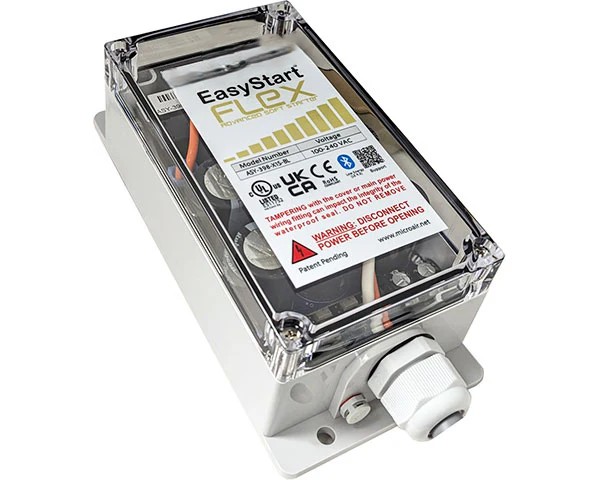Soft start in chillers is a crucial feature in modern HVAC systems, designed to minimize electrical stress and mechanical wear during compressor startup. Instead of delivering full voltage instantly—as in traditional starters—a soft starter gradually ramps up power, allowing the motor and compressor to reach operating speed smoothly. This not only extends the equipment lifespan but also reduces high inrush current, improves energy efficiency, and prevents voltage dips across the facility. Soft start technology is especially beneficial in large-capacity chillers used in data centers, pharmaceuticals, manufacturing plants, and commercial cooling applications. By providing a controlled start, it ensures system stability, operational safety, and long-term cost savings.
Detailed Functional Working of Soft Starters
When a soft starter is used in a chiller, it works by modulating the voltage supplied to the motor during startup. Here’s how it works:
- Phase Angle Control: Silicon-Controlled Rectifiers (SCRs) adjust the timing of voltage delivery to reduce the effective voltage.
- Ramp-Up Profile: A software-defined ramp slowly increases voltage from 0% to 100% over a pre-set time (typically 5–15 seconds).
- Current Limit Mode: Limits inrush current to a safe level (~150% of FLA), compared to 600%+ in DOL starts.
- Bypass Mode: After the motor reaches full speed, a bypass contactor engages, reducing heat generation in the SCRs and improving energy efficiency.
Smart starters now include advanced digital control with real-time data feedback, event logging, and cloud communication protocols—helping companies move toward Industry 4.0 readiness.
Stronger Emphasis on Benefits and Technical Value
Drastic Reduction in Inrush Current
Without a soft starter:
- A 75 kW motor draws over 450A on startup, even if FLA is 75–80A.
- This may trip circuit breakers, damage contactors, or overload transformers.
With soft starter: - Startup current is controlled and remains below 2–2.5× FLA, preventing electrical stress.
Real-world outcome: Prolonged switchgear life, smaller transformer sizing, and elimination of demand surcharges.
Compressor Protection in Harsh Environments
In tropical or industrial zones, chiller compressors face:
- Frequent on/off cycling
- High ambient temperatures
- Voltage fluctuations
Soft starters reduce startup stress and maintain steady operation—ensuring components like motor windings, bearings, and oil separators last longer.
Example: Screw compressors in 24×7 plastic molding units benefit from soft starts that reduce gear mesh damage and oil turbulence.
Better Refrigerant Circuit Balance
A rapid startup can cause a pressure differential spike between the evaporator and compressor. This leads to:
- Suction superheat problems
- Flash gas formation
- Refrigerant starvation or flooding
With a soft starter:
- Pressures equalize slowly
- Flow stabilizes gradually
- Evaporator performance improves
Result: Improved Coefficient of Performance (COP) and reduced trip-outs from low/high pressure switches.
Ideal for Power-Constrained Facilities
In rural factories, older buildings, or mobile generator-based setups, soft starters prevent:
- Sudden voltage drops
- Flickering lights
- PLC/automation system reboots
This makes chillers usable even in low-capacity electrical grids.
Especially useful in:
- Remote milk chilling centers
- Offshore marine cooling systems
- Mobile HVAC setups
Smart Diagnostic Features
Modern soft starters are equipped with:
- Load curve monitoring
- Stall detection
- Motor undercurrent/overcurrent alerts
- Ground fault warnings
They integrate with:
- Building Management Systems (BMS)
- SCADA
- IoT dashboards
Maintenance teams receive early warnings of:
- Bearing wear
- Misalignment
- Locked rotor issues
Energy Efficiency & Lifecycle Cost Advantage
While soft starters don’t offer speed modulation like VFDs, they significantly:
- Reduce thermal losses during startup
- Eliminate unnecessary shutdowns
- Cut energy cost over long chiller life
Payback: Many soft starters pay back their investment in under 12 months in power-demand-based billing systems.
Soft start in chillers is more than just a technical add-on—it’s a smart investment in performance, protection, and efficiency. With the growing demand for energy optimization and system reliability, soft starters provide a critical advantage by reducing compressor stress, minimizing startup surges, and enhancing electrical safety. They are particularly valuable in industries where frequent cycling, voltage sensitivity, or load fluctuations are common. Whether applied in commercial buildings or industrial cooling systems, soft start technology ensures that chillers operate smoothly from the very first second—boosting lifespan, minimizing downtime, and supporting smarter energy usage.

